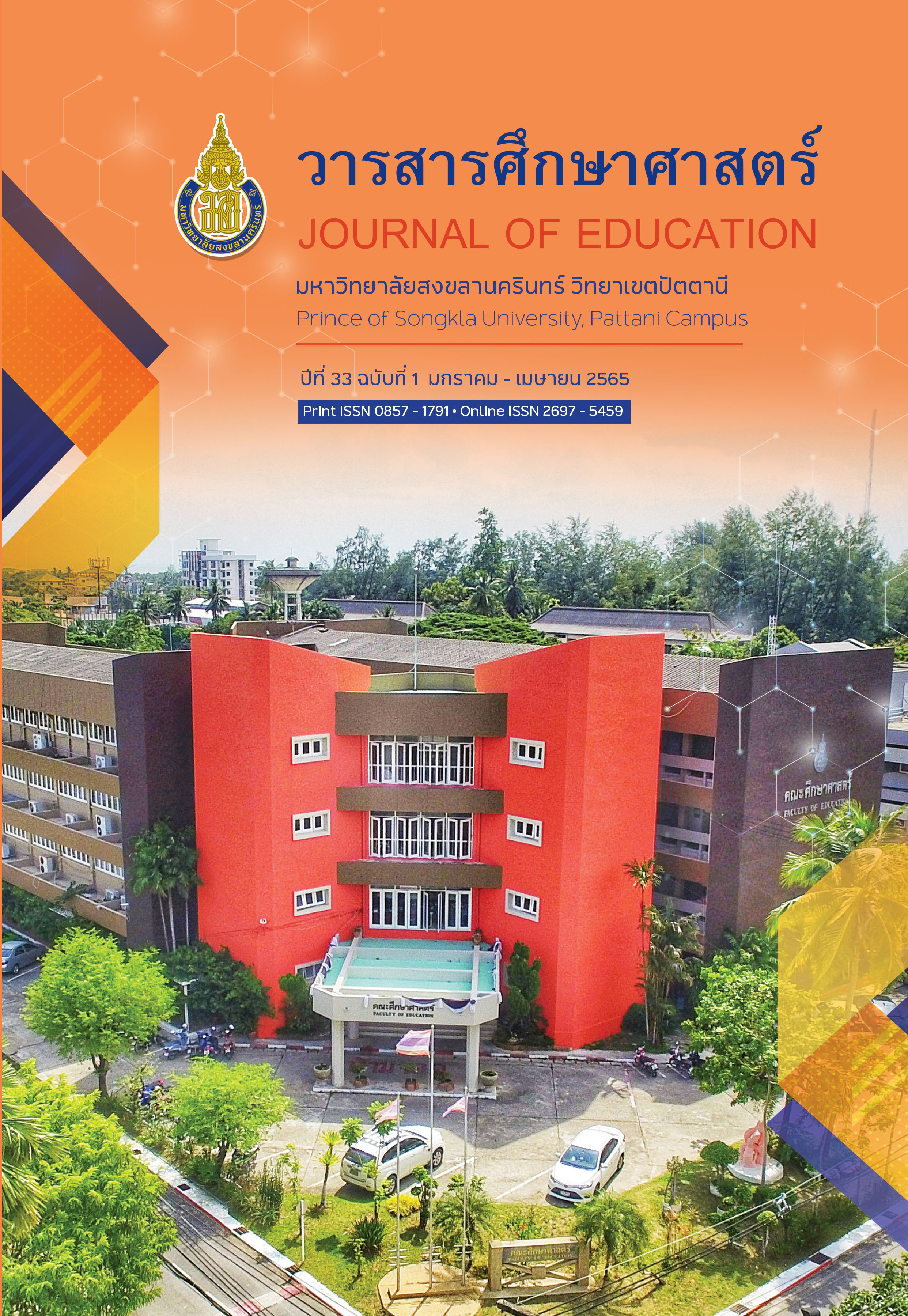ศึกษาวิเคราะห์ลักษณะการนำเสนอไวยากรณ์ที่ปรากฏในหนังสือเรียนภาษาเกาหลีขั้นพื้นฐาน สำหรับนักศึกษาระดับอุดมศึกษาในประเทศไทย
Main Article Content
บทคัดย่อ
การศึกษานี้มีวัตถุประสงค์เพื่อวิเคราะห์การนำเสนอไวยากรณ์ที่ปรากฏในหนังสือเรียนภาษาเกาหลีขั้นพื้นฐานสำหรับนักศึกษาระดับอุดมศึกษาในประเทศไทย ในด้านหลักสูตรและเนื้อหารายวิชา ส่วนประกอบของเนื้อหา วิธีการอธิบายและนำเสนอไวยากรณ์ การยกตัวอย่างประโยค และการสร้างแบบฝึกหัด กลุ่มตัวอย่าง คือ หนังสือเรียนภาษาเกาหลีขั้นพื้นฐานที่ใช้ประกอบการสอนไวยากรณ์ภาษาเกาหลี จำนวน 16 เล่ม ใช้วิธีวิเคราะห์เอกสาร (Documents analysis approach) ตามเกณฑ์การวิเคราะห์ไวยากรณ์ที่ปรากฏในหนังสือ ผลการศึกษา พบว่า 1) ด้านหลักสูตรและเนื้อหารายวิชามีความสอดคล้องกับหนังสือเรียนภาษาเกาหลีขั้นพื้นฐาน แต่ระยะเวลา
ที่ใช้ในการจัดการเรียนการสอนไม่สอดคล้องกับระยะเวลาที่กำหนดในหลักสูตร 2) ด้านส่วนประกอบของหนังสือมีความเหมาะสมกับระดับความรู้ของผู้เรียน เนื้อหาไวยากรณ์ตรงตามวัตถุประสงค์ของรายวิชา โดยวิธีการถ่ายทอดเนื้อหาไวยากรณ์มี 2 รูปแบบ คือ (1) นำเสนอความหมาย กฎการใช้ และข้อกำหนดการใช้ไวยากรณ์ และ
(2) นำเสนอเฉพาะรูปประโยคโดยให้ศึกษาความหมาย กฎการใช้ และข้อกำหนดจากตัวอย่างประโยค 3) ด้านวิธีการอธิบายและนำเสนอไวยากรณ์ มี 2 รูปแบบ คือ (1) นำเสนอคำอธิบายและความหมาย วิธีการใช้ และข้อกำหนดไวยากรณ์เป็นภาษาอังกฤษกับภาษาเกาหลี และ (2) นำเสนอคำอธิบายและความหมายจากตัวอย่างประโยค 4) ด้านการนำเสนอตัวอย่างประโยคมี 2 ลักษณะ คือ (1) การนำเสนอทีละประโยค และ (2) นำเสนอเป็นบทสนทนา 5) ด้านแบบฝึกหัด ยังไม่มีความหลากหลาย เป็นแบบฝึกหัดที่ฝึกให้สร้างบทสนทนาจากไวยากรณ์ที่เรียน เน้นการฝึกให้จำการใช้โครงสร้างไวยากรณ์มากกว่าการประยุกต์ใช้ไวยากรณ์
Article Details

อนุญาตภายใต้เงื่อนไข Creative Commons Attribution-NonCommercial 4.0 International License.
เอกสารอ้างอิง
Cunnings worth, A. (1995). Choosing your coursebook. Oxford: Macmillan Heinemann.
Do, O. (2006). A Study of Investigates the Influence of Korean Grammar and Direction of Improvement in Thailand. Department of Korean Language Education as a Foreign Language. The Graduate School of Education. [Master’s thesis, Seoul: Ewha Womans University].
Kang, H. (2006). An Alternative Korean Grammar Education Method. Korean Language Education Research Institute. Seoul National University, 18(0), 31-60.
Kang, S. (2010). A study on the actual condition of English-speaking standard Korean textbooks and development plan. National Institute of the Korean Language.
Khongpheng, S. (2012). Development of Korean textbooks for high school students in Thailand. [Master’s thesis, Seoul: Korea University].
Kim, J. (2002). Korean syllabus design and textbook composition, edited by Park Young-soon [The Current State and Tasks of Korean Language Education in the 21st Century], Korean Cultural History.
Lee, H. (2001). The Analysis of the Korean Textbook: A Learner - centered Approach. The International Association for Korean Language Education. 12(1) 199-232.
Lee, H. (2006). The vocabulary and grammar Learning activities for Korean textbooks. Teaching Korean as a Foreign Language. Korean Language Institute. Yonsei University 31, 25-56.
Lee, H. (2009). The improvement for Korean course of study through analyzing a Korean language teaching materials. Graduate school of Education. [Master’s thesis, Seoul: Changwon National University].
Lee, M. (2005). A Study of Teaching Korean Grammar: Focused on the speculative expressions. [Ph.D dissertation. Seoul: Ewha Womans University].
Intrarat, M. (2016). A Study of Korean language Curriculum and Coursebook Design for Thailand Secondary School through Coursebooks Analysis. Department of Korean Studies The Graduate School of International Studies. [Master’s thesis, Seoul: Ewha Womans University].
Min, H. (2002). Current status and tasks of Korean grammar education as a second language. New Korean Life, 10(2). National Institute of the Korean Language.
Min, H. (2005). Urgent Problems of Standardization and Diversification in the Education of Grammar. Korean Language Education Research Institute. Seoul National University, 16(0), 125-191.
Sahaviriya, K. (2016). A Study on Teaching Method of Korean Guessing Expression for Thai Learners. Pattani: Prince of Songkla University.
Sahaviriya, K., Kanghae, S. (2019). The Study of the Development Approach of the Korean Fundamental Grammars Textbook for Higher education studies in Thailand. Department of Eastern Languages, Faculty of Humanities and Social Sciences, Prince of Songkla University, Pattani Campus.
Saeng-Athiwat, K. (2017). Concepts of English teaching and learning management. accessible Retrieved from https://sites.google.com/site/itsmekodkant/khlang-bthkhwam-khxngchan/naewkhidnikarcadkarreiynkarsxnphasaxangkvs
Seo, J. (2001). Notice of evaluation standards for Korean language textbooks for foreign learners. Ulsan Language Collections 15. Ulsan University.
Song, Y. (2010). Teaching of Korean Particles Based on the Analysis of Thai Students’ Needs of Korean. Department of Korean Language Education. Graduate School of Education. [Master’s thesis, Seoul: Han Nam University].
Wongthanasen, P. (2009). Korean language principles. Educational Technology Department Office of Academic Resources, Prince of Songkla University, Pattani Campus.
Korean Language & Culture Center, Institute of Foreign Language Studies, Korea University. (2009). Fun! Fun! Korean 1. KYO BO Book Centre.
Korean Language & Culture Center, Institute of Foreign Language Studies, Korea University. (2009). Fun! Fun! Korean 2. KYO BO Book Centre.
Korean Language & Culture Center, Institute of Foreign Language Studies, Korea University. (2009). Fun! Fun! Korean 3. KYO BO Book Centre.
Korean Language Education Center, Sogang University. (2000). Sogang Korean 1A. Hawoo Publishing Inc.
Korean Language Education Center, Sogang University. (2000). Sogang Korean 1B. Hawoo Publishing Inc.
Korean Language Education Center, Sogang University. (2000). Sogang Korean 2A. Hawoo Publishing Inc.
Korean Language Education Center, Sogang University. (2000). Sogang Korean 2B. Hawoo Publishing Inc.
Korean Language Education Center, Sogang University. (2000). Sogang Korean 3A. Hawoo Publishing Inc.
Korean Language Education Center, Sogang University. (2000). Sogang Korean 3B. Hawoo Publishing Inc.
Korean Language Education Center. (2009). Korean 1. MOONJIN MEDIA.
Korean Language Education Center. (2009). Korean 2. MOONJIN MEDIA.
Korean Language Education Center. (2009). Korean 3. MOONJIN MEDIA.
Lee, J. Kim, J. Cho, H. Seo, Y. Yun, H. Yun, Y. (2015). Get It Korean Grammar 1. Hawoo Publishing Inc.
Lee, J. Kim, J. Cho, H. Seo, Y. Yun, H. Yun, Y. (2015). Get It Korean Grammar 2. Hawoo Publishing Inc.
Lee, J. Kim, J. Cho, H. Seo, Y. Yun, H. Yun, Y. (2015). Get It Korean Grammar 3. Hawoo Publishing Inc.
Lee, J. Kim, J. Cho, H. Seo, Y. Yun, H. Yun, Y. (2015). Get It Korean Grammar 4. Hawoo Publishing Inc.


